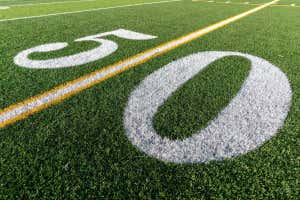Athletes may have higher risk of concussion on artificial grass
An analysis of different outdoor playing surfaces suggests that falls on artificial turf may pose a greater concussion risk than natural grass
Health
7 October 2022
Artificial turf is a harder playing surface than natural grass, which can increase injury risk
Thomas Farlow / Alamy Stock Photo
Athletes playing on synthetic grass surfaces may be at higher risk for concussion than those playing on natural grass.
Among high school athletes in the US, about 20 per cent of concussions result from the person hitting their head on the playing surface.
Artificial turf is becoming increasingly popular across the country: it is estimated that there are currently more than 16,000 synthetic grass fields in the US, and as many as 1500 new ones being built each year.
Several studies have shown that ankle and knee injuries are more common on harder synthetic playing fields compared to grass, both among professional athletes and amateur players. Yet Ian Chun at the University of Hawaii says there isn’t “very much information on different rates of concussions due to field hardness”.
Chun conducted a series of experiments in which he dropped a 20-kilogram mannequin onto 10 natural grass playing fields and 9 artificial turf surfaces. Chun placed accelerometers onto the right ear, top of the head and forehead of the mannequin, before fitting it with an American football helmet. He then dropped it off a table from a height of 170 centimeters – chosen to simulate the height of a teen athlete – with the mannequin landing either on its left side, front or back and measured the impact.
After 1710 total drops, Chun found that impact deceleration – a measure of how abruptly something in motion is brought to a halt – was significantly higher on synthetic playing fields in all three falling positions. Depending on drop position, deceleration measured in g-forces was as much as 23 g higher on artificial grass compared to natural surfaces. Previous research has shown that an impact of 40 g or higher increases the chance for concussion, but some people can sustain a concussion at lower forces.
“Our study suggests that synthetic fields are a harder playing surface. This translates to a theoretical increased risk of concussion due to contact with playing surfaces,” says Chun, who is presenting this work on October 8 at the American Academy of Pediatrics Conference and Exhibition in California.
Sudden deceleration of the brain within the skull is known to be a cause of concussion. “I think future research in observing actual rates of concussions in different playing fields and environments would be an interesting follow-up study and solidify the link between harder playing surfaces and concussion risks,” says Chun.
Kristen Dams-O’Connor at Mount Sinai Hospital in New York says that these findings point to a possible way that we could reduce injury risk. “We’re at this very interesting crossroads now where evidence has accumulated that even in the absence of a concussion, there is risk to brain health in contact sports,” she says.
Dams-O’Connor says she’d like to see additional work confirming the results and conducting similar tests of other playing surfaces. “We should be considering every possible avenue to make sports safer,” she says.
More on these topics:


Comments are closed.